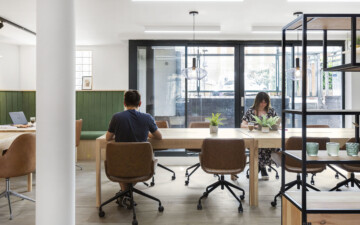Notwithstanding the ostensible popularity of working from home (WFH), there is some research to suggest that productivity of home workers remains low in comparison to that at the workplace. According to research mentioned by The Washington Post, a long-term switch to remote work would adversely impact both innovation and productivity. For many in big cities such as London – where living quarters are often cramped – working from home typically means working from one’s kitchen or bedroom which isn’t always productive or fun. Besides the myriad distractions – doorbells ringing, crying babies at the neighbour’s, sudden household chores – the isolation of WFH can get somewhat frustrating for extroverts and anyone else who misses the social interaction and collaboration afforded by a traditional office setting. All the same, with flexibility being touted as the future of work, WFH – or the autonomy of it – isn’t going away anytime soon. It is perhaps this ambivalence that is leading an ever-growing number of companies to embrace hybrid work arrangements.
The Relation between Co-Working and Hybrid Work
Organisations are increasingly coming round to allowing their employees flexibility in order to maximise employee satisfaction and retention. In this scenario, while many are choosing to work from home, there are others, who prefer the vibrant social atmosphere of an actual office. With companies giving employees the freedom to choose their work environment, co-working spaces are effectively bridging the gap between these two sets of employees. Such offices provide workers struggling with WFH a professional private space for client meetings, access to new technology, and opportunities for social interactions. Likewise, companies gain by having increased access to networking opportunities within and across industries and saving energy and money, spent otherwise on logistical and operational requirements.
Building Workplace Culture in a Hybrid Workplace
At a hybrid workplace, remote work is combined with office work. Employees typically divide their time between WFH and working from a designated workplace. While this model of work is likely here to stay for good, it currently faces a few serious challenges. One of these is how a workplace culture – core values and guiding philosophy – can be built and fostered over time. Here are a few valuable suggestions:
-
Articulate & Share Company Goals
Company leaders must outline goals and a vision, envisaging a roadmap for themselves and their employees. Further, they must clearly articulate the same, discussing the bigger picture and ensuring that employees feel their work is uniquely connected with and intrinsic to the success of the organisation.
To foster and sustain a strong positive culture in a hybrid work arrangement, leaders must encourage people to build their networks. They can help employees connect across departments via knowledge-sharing sessions and virtual coffee discussions, facilitating cross-functional learning opportunities and effective decision-making.
Letting employees have fun is an effective way to foster company culture. There could be music battles, online Zumba classes, happy hours, virtual lunches, and other relaxing group events to help employees stay motivated and build connections with colleagues.
-
Pay Attention to Wellness
The organisation’s leaders should promote the health and wellness of employees. They could, for instance, give access to resources and tools – a digital health coaching programme or online personalised wellness engagement platforms – to help employees grappling with personal issues or stress.
Leaders must choose the right workplace for strengthening culture in a hybrid work set-up. This means appealing workspaces that help people work better, as well as learn, collaborate, socialise and rejuvenate. It means office-spaces that stimulate and inspire, even as they lend comfort, giving workers a sense of control over their surroundings.
To sum up, building and strengthening culture in the hybrid work experience – like at a real office set-up – won’t happen by default. The key is to maintain the effort and conscientiousness, while deploying the right tools and methods for this critical exercise.





